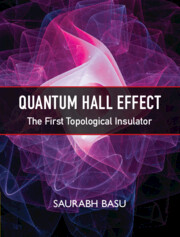Book contents
- Frontmatter
- Dedication
- Contents
- Foreword
- Preface
- Acknowledgements
- 1. Quantum Hall Effect
- 2. Symmetry and Topology
- 3. Topology in One-Dimensional (1D) and Quasi-1D Models
- 4. Quantum Hall Effect in Graphene
- 5. Graphene as a Topological Insulator: Anomalous Hall Effect
- 6. Fractional Quantum Hall Effect
- Epilogue
- Bibliography
- Index
Epilogue
Published online by Cambridge University Press: aN Invalid Date NaN
- Frontmatter
- Dedication
- Contents
- Foreword
- Preface
- Acknowledgements
- 1. Quantum Hall Effect
- 2. Symmetry and Topology
- 3. Topology in One-Dimensional (1D) and Quasi-1D Models
- 4. Quantum Hall Effect in Graphene
- 5. Graphene as a Topological Insulator: Anomalous Hall Effect
- 6. Fractional Quantum Hall Effect
- Epilogue
- Bibliography
- Index
Summary
Quantum Hall states are the first examples of topological insulators that demonstrate completely contrasting electronic behavior between the bulk and the edges of the sample. The bulk of the system is insulating, while there exists conducting states at the edges. Moreover, the Hall conductivity is quantized in units of a universal constant, e2/h. It became clear later on that the quantization is actually related to a topological invariant known as the Chern number. The geometric interpretation of this invariant is provided by the Gauss–Bonnet theorem, which relates the integral of the Gaussian curvature over a closed surface to a constant that simply counts the number of ‘genus’ (or holes) of the object. In solid state physics, the closed surface is the Brillouin zone, and the Gaussian curvature is analogous to a quantity known as the Berry curvature, integral of which over the Brillouin zone yields the quantization of the Hall conductivity.
In Chapter 1, we begin with a historical overview of the quantum Hall effect. The experiment and the physical systems are described with an emphasis on the two-dimensional (2D) nature of the ‘dirty’ electronic system in the presence of a strong perpendicular magnetic field at low temperature. The Hall resistivity as a function of the field shows quantized plateaus in unit of h/e2 with an accuracy of one part in more than a billion. Very surprisingly, the longitudinal resistivity synergetically vanishes at the positions of the plateaus for the Hall resistivity. This indicates the emergence of a phase with an inherent ambiguousness of being a perfect conductor and a perfect insulator at the same time. However, such an ambiguity can only be reconciled for an electron gas confined in a plane in the presence of a magnetic field.
Quite intriguingly, the presence of the perpendicular magnetic field introduces ‘another’ quantization, which replaces the band structure (energy as a function of the wavevector) of the electronic system. This quantization was shown via solving the Schrödinger equation in the presence of a Landau gauge. The resultant energy levels of this problem are the infinitely degenerate Landau levels, which slightly broaden due to the presence of impurity and disorder but still remain distinct and cause quantization of the Hall conductivity as the magnetic field is ramped up gradually.
- Type
- Chapter
- Information
- Quantum Hall EffectThe First Topological Insulator, pp. 207 - 210Publisher: Cambridge University PressPrint publication year: 2024



